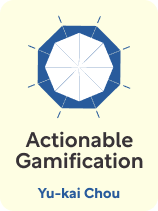

This article is an excerpt from the Shortform book guide to "Actionable Gamification" by Yu-kai Chou. Shortform has the world's best summaries and analyses of books you should be reading.
Like this article? Sign up for a free trial here.
What does gamification engagement mean? How can you create more engaging mechanics to boost player motivation?
Gamification engagement refers to the use of game elements in non-game contexts to motivate individuals to engage with a brand or product. According to gamification consultant Yu-kai Chou, businesses often fail to integrate gamification elements effectively, leading to a loss of engagement.
Keep reading to learn Chou’s three tips for boosting player engagement with a gamification system.
Gamification Engagement Strategies
Games have the power to unlock deep reserves of human motivation that drive customer and employee behavior. However, many businesses that try to incorporate game elements into their business strategy end up failing. Yu-kai Chou can explain why. As a professional gamification consultant, he explains how to boost engagement by sharing the most effective ways to incorporate game elements into your business strategy. In this article, we’ll explain Chou’s gamification engagement strategies, according to the advice in his book Actionable Gamification.
Strategy #1: Cultivate a Sense of Purpose
Chou’s first strategy for gamification engagement is cultivating a sense of purpose. Games motivate and engage people by making them feel like they’re doing something meaningful and important. Many games create a narrative where the player is a hero—it’s up to them to rescue a princess or thwart the supervillain’s evil plans. These narratives motivate players by providing a long-term goal and by casting players in the role of someone uniquely qualified to carry out this quest.
For your gamification system, consider the story you tell about your players. If you are gamifying your workplace, it could be a story about how your employees are making the world a better place because of your product or service. For example, if you’re selling lawn care, the salespeople are the “heroes” rescuing their customers from the “danger” of tedious yard work and boring weekends spent mowing the grass.
Players will also feel they are contributing to something important if you can tie your game objectives to a worthy cause. For example, if your company donates a percentage of the proceeds to a charity, this gives customers the feeling that they’ve done something important every time they make a purchase.
(Shortform note: In The Hero With a Thousand Faces, Joseph Campbell explains why so many people are drawn to the mythology of heroes. Campbell states that the hero’s journey is an introspective psychological allegory of personal growth. Heroes begin their journey in a state of familiarity and comfort. However, they must take the risk of entering into the unknown to unlock their full power and potential. According to Campbell, this mirrors the process by which people experiment, explore, and take risks in their lives that leads to maturity and personal growth.)
Strategy #2: Reinforce Growth and Achievement
People also feel a sense of engagement with gamification systems when they feel that they’ve grown and achieved something in the game. Chou asserts that players like overcoming challenges, developing their skills, and being able to look back and see how much they’ve grown. This explains the satisfaction people get from hobbies that require learning, like taking up a musical instrument or mastering a sport. Even if the hobbyist has no intention of trying to become a professional, they find it rewarding to get better at something.
Chou recommends several methods to create a visible record of achievement and growth to reinforce this motivation. The first method is to provide players with badges of achievement that represent different stages of mastery—in a non-game context, this might take the form of credentials and degrees for completing educational programs. For example, Apple has a tiered system of titles for engineers, in which employees graduate from level one to level five.
Secondly, you can also unlock your players’ desire for progress and achievement by measuring that achievement through points and leaderboards. Chou suggests that allowing players to earn points as they practice tasks and develop their skills will reinforce their motivation to continue practicing and growing. Displaying these points with a leaderboard can give players a chance to compete with each other in developing this skill.
| Why Reinforcement Motivates Us to Continue Achieving Psychological research sheds light on why reinforcement is so powerful at motivating someone to continue achieving. Researchers have found that past experience often trumps other forms of information in decision-making. Therefore, having a positive result in the past can override descriptive or verbal information discouraging someone from a decision. Some researchers argue that this has to do with the human brain’s natural dopamine system. Dopamine is a chemical that triggers excitement and motivation at the expectation of a reward. The memory of past rewards will therefore stimulate this chemical source of motivation. This is why so many effective games reinforce behaviors with points, badges, trophies, or other rewards: The memory of a reward stimulates a dose of chemical motivation when faced with a similar situation. This motivates the player to continue pushing themselves to achieve even more. |
Strategy #3: Encourage Relationships
Humans are social creatures by nature. Therefore, many games motivate people to stay engaged and keep coming back through socializing and relationship-building. Chou suggests any gamification mechanic that involves teamwork, collaboration, group formation, or even competition between players can use social dynamics to promote player engagement. He offers three strategies to incorporate this into your gamification system.
1) Foster Mentorship
Chou suggests that you can leverage the motivating power of relationships by creating mentor/mentee relationships between players of differing skill levels. By being mentored, newer players will feel a sense of engagement with your gamification system because they feel that someone else is investing their time and energy in their development. Mentorship opportunities will also give more experienced players a reason to stay invested in the game longer.
| Why Are Mentor/Mentee Relationships So Rewarding? In designing your mentorship opportunities, it helps to take a look at why people are motivated to mentor each other and what makes for a successful mentor relationship. Writing in Drive, Daniel Pink argues that people are naturally hardwired to want to help others. Some psychologists also argue that age plays a role. When people reach middle age, they often enter a stage of life called “generativity” in which people tend to focus more on investing in the next generation. Psychologists have also found that the best mentor/mentee relationships are founded on mutual sharing and reciprocity—that is, the more experienced party doesn’t only provide information, both parties get to know each other and build a trusting relationship together. Research has also found that despite these benefits, mentor relationships don’t always happen on their own. This is why it is helpful to consider giving people the option to sign up for a mentor program and then intentionally pairing them together. |
2) Create a Community
Chou states that you can motivate your players by fostering a sense that they are contributing to a community. People are often deeply devoted to their communities and group identities. If someone feels they belong to a community, they will naturally want to contribute to the group and keep coming back for a sense of belonging.
Chou explains that communities also motivate people and create a sense of engagement with a gamification system through peer pressure. If you can create a situation where player communities establish clear norms of behavior, this can motivate new users to follow suit upon joining the community. Let’s say your product has a message board where users can post about their experience. New users will be more likely to start using a feature if they see others in the community doing it first.
(Shortform note: In The Power of Moments, Chip and Dan Heath shed light on why group experiences can be so rewarding. They explain that group experiences build connections between people. As people form connections, they deepen their mutual understanding, feel a sense of validation, and feel more cared about. However, Chip and Dan Heath also argue that merely spending time together in a group setting is not enough—people need to share meaningful moments together. To create these moments for people, they recommend allowing people to struggle together or connect over a shared goal or mission.)

———End of Preview———
Like what you just read? Read the rest of the world's best book summary and analysis of Yu-kai Chou's "Actionable Gamification" at Shortform.
Here's what you'll find in our full Actionable Gamification summary:
- How to use gamification to grow your business
- Why some gamification systems are addictive and others fail
- How to keep players engaged and motivated






